-
 Bitcoin
Bitcoin $107,397.3430
-0.20% -
 Ethereum
Ethereum $2,467.5633
1.33% -
 Tether USDt
Tether USDt $1.0002
0.01% -
 XRP
XRP $2.1994
0.71% -
 BNB
BNB $655.8723
1.07% -
 Solana
Solana $157.3780
4.63% -
 USDC
USDC $1.0000
0.02% -
 TRON
TRON $0.2792
1.23% -
 Dogecoin
Dogecoin $0.1645
0.50% -
 Cardano
Cardano $0.5666
1.83% -
 Hyperliquid
Hyperliquid $39.8730
3.91% -
 Bitcoin Cash
Bitcoin Cash $514.7673
5.02% -
 Sui
Sui $2.7969
-0.51% -
 Chainlink
Chainlink $13.2880
0.07% -
 UNUS SED LEO
UNUS SED LEO $9.1148
-0.60% -
 Avalanche
Avalanche $17.9247
0.34% -
 Stellar
Stellar $0.2351
-0.98% -
 Toncoin
Toncoin $2.9456
2.69% -
 Shiba Inu
Shiba Inu $0.0...01144
-0.74% -
 Litecoin
Litecoin $85.9064
-0.62% -
 Hedera
Hedera $0.1495
1.47% -
 Monero
Monero $319.0339
3.82% -
 Polkadot
Polkadot $3.3940
-0.40% -
 Dai
Dai $1.0000
0.01% -
 Ethena USDe
Ethena USDe $1.0003
0.00% -
 Bitget Token
Bitget Token $4.5223
-1.95% -
 Uniswap
Uniswap $7.1384
-0.02% -
 Aave
Aave $272.7534
0.72% -
 Pepe
Pepe $0.0...09836
2.57% -
 Pi
Pi $0.5107
-2.06%
Is it a mid-term buying point when the volume shrinks and steps back on the 5-week line in the upward trend?
The 5-week moving average helps identify mid-term crypto buying opportunities when combined with volume analysis and trend confirmation.
Jun 30, 2025 at 07:49 pm
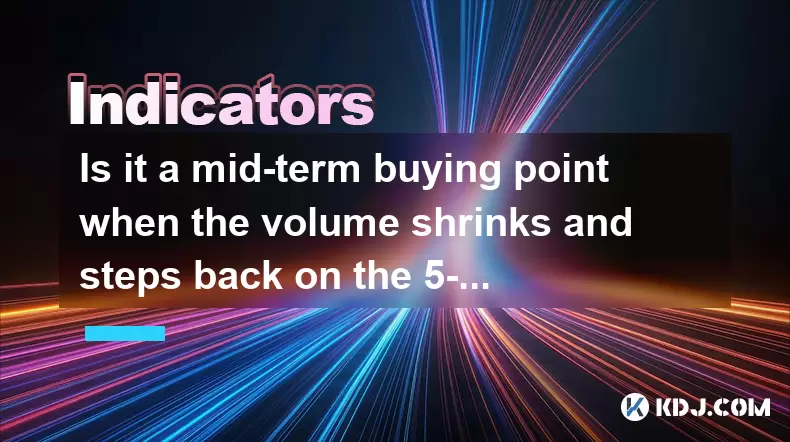
Understanding the 5-Week Moving Average in Cryptocurrency Trading
In cryptocurrency trading, technical indicators such as the 5-week moving average are widely used to assess long-term trends. This indicator smooths out price volatility over a five-week period and provides traders with a clearer picture of the direction in which an asset is moving. When analyzing whether it's a mid-term buying point, understanding how price interacts with this line becomes crucial.
The 5-week moving average acts as a dynamic support or resistance level depending on the trend. In an upward trend, if the price pulls back toward this moving average while maintaining overall bullish momentum, it can signal a potential re-entry opportunity. However, confirmation through volume behavior is essential before making any decision.
Key Takeaway:
The 5-week moving average serves as a critical reference for mid-term investors in identifying trend strength and potential pullback zones.The Role of Volume in Confirming Trend Integrity
Volume plays a central role in validating price action. A shrinking volume during a pullback often indicates that selling pressure is decreasing rather than increasing. This is especially relevant when the broader trend remains intact. In many cases, smart money accumulates assets quietly during low-volume retracements, setting up for the next leg up.
When the price steps back toward the 5-week line and volume contracts, it suggests that bears are losing control and bulls may soon resume dominance. Traders should monitor candlestick patterns and order flow during these periods to identify early signs of reversal.
- Check if the volume drops below its 10-day average
- Observe whether the decline happens near key moving averages
- Compare current volume levels with previous corrections
Important Tip:
Shrinking volume alone isn't enough—always cross-check with price structure and trend alignment.How to Identify a Valid Mid-Term Pullback Setup
To determine if a pullback is valid and offers a mid-term entry opportunity, several conditions must align. First, the overall uptrend must remain intact. This means higher highs and higher lows should still be visible on the weekly chart. Second, the pullback should not violate major moving averages like the 20-week line unless it's a temporary shakeout.
Another important condition is that the pullback occurs after a healthy rally, indicating that buyers previously had control. If the decline happens too early in the trend, it might be a false signal. Also, Fibonacci retracement levels can help determine possible support zones near the 5-week line.
- Ensure the 50-week moving average hasn’t been breached
- Look for confluence between Fibonacci levels and the 5-week MA
- Confirm that RSI or MACD doesn’t show bearish divergence
Critical Insight:
A valid pullback setup requires multiple confirming signals—not just proximity to the 5-week line.Practical Steps to Execute the Trade
If all conditions suggest a potential mid-term buying opportunity, executing the trade correctly becomes vital. Entering too early could lead to unnecessary losses, while waiting too long might result in missing the move entirely.
Begin by placing a limit buy order slightly above the expected bounce zone. Use a tight stop-loss just below the recent swing low or under the 5-week moving average. Position sizing should reflect risk tolerance and the confidence level in the setup.
- Determine your maximum acceptable risk per trade (e.g., 1–2%)
- Calculate the distance from entry to stop-loss to define position size
- Set profit targets based on previous swing highs or Fibonacci extensions
Pro Tip:
Always use a trailing stop once the trade moves into positive territory to protect gains.Common Pitfalls to Avoid in Mid-Term Pullback Trades
Many traders fail to profit from valid setups due to common mistakes. One such mistake is ignoring macroeconomic factors or market sentiment. Even if technical indicators look favorable, external news or regulatory changes can invalidate a setup quickly.
Another frequent error is over-leveraging on pullbacks. Since pullbacks can extend further than anticipated, using excessive leverage increases the risk of liquidation. It’s also important not to chase entries—patience pays off in mid-term trading.
- Avoid entering without proper risk-reward ratios
- Don’t ignore divergences in momentum indicators
- Stay away from emotional trading—stick to your plan
Warning:
Never assume a bounce will happen just because the price hits the 5-week line.Frequently Asked Questions
Q: Can I apply this strategy to altcoins?
Yes, but ensure that the altcoin has sufficient liquidity and follows a clear trend. Not all altcoins behave similarly to Bitcoin or Ethereum, so additional analysis may be required.
Q: What time frame should I focus on for confirmation?
Weekly and daily charts provide the most reliable context for mid-term trades. The weekly chart defines the trend, while the daily chart helps time the entry more precisely.
Q: Should I wait for a candlestick reversal pattern before entering?
It’s highly recommended. Patterns like hammer candles, bullish engulfing, or morning star formations increase the probability of a successful bounce.
Q: How do I handle fakeouts near the 5-week line?
Use filters like volume and momentum to avoid false breakouts. Consider waiting for a close above or below the line instead of reacting to intraday touches.
Disclaimer:info@kdj.com
The information provided is not trading advice. kdj.com does not assume any responsibility for any investments made based on the information provided in this article. Cryptocurrencies are highly volatile and it is highly recommended that you invest with caution after thorough research!
If you believe that the content used on this website infringes your copyright, please contact us immediately (info@kdj.com) and we will delete it promptly.
- Unlock Crypto Riches: Mining Platforms & Starter Bonuses - Your Gateway to Digital Gold!
- 2025-06-30 22:30:11
- Dogecoin, Cloud Mining, and Risk Alerts: Navigating the Meme Minefield
- 2025-06-30 22:30:11
- Ric Edelman's Bold Crypto Allocation: A Financial Advisor's Perspective
- 2025-06-30 22:50:12
- Bitcoin Layer-2 Presale Heats Up: Is HYPER the Next Big Thing?
- 2025-06-30 22:50:12
- Bitcoin's Bull Run: Network Activity Tells a Different Story
- 2025-06-30 22:55:12
- SpacePay, Altcoins & Investing in 2025: What's the Buzz?
- 2025-06-30 23:10:12
Related knowledge
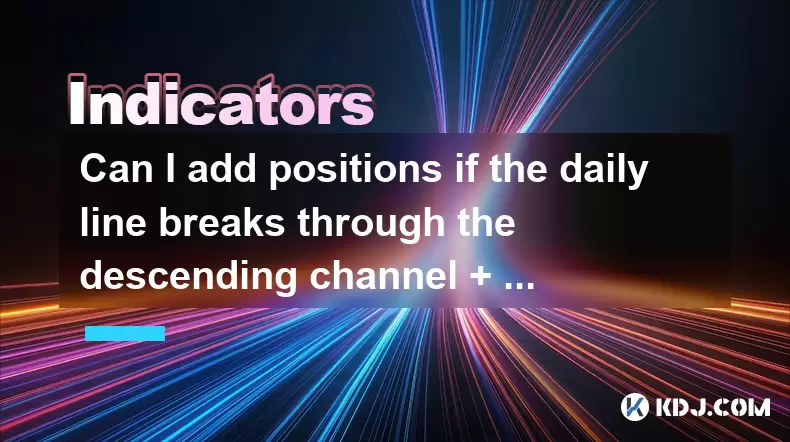
Can I add positions if the daily line breaks through the descending channel + the 30-minute moving average is in a bullish arrangement?
Jun 30,2025 at 11:00pm
Understanding the Descending Channel BreakoutWhen a daily line breaks through a descending channel, it indicates a potential shift in market sentiment from bearish to bullish. A descending channel is formed by drawing two parallel trendlines, where the upper trendline connects the lower highs and the lower trendline connects the lower lows. A breakout o...
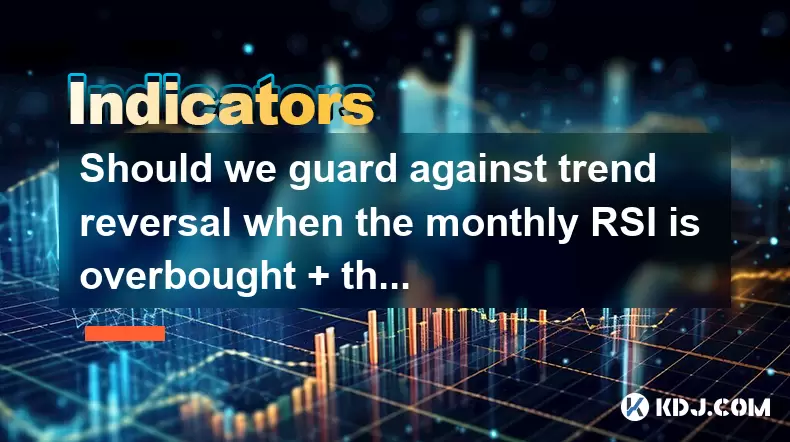
Should we guard against trend reversal when the monthly RSI is overbought + the weekly line has a long upper shadow?
Jun 30,2025 at 11:35pm
Understanding RSI Overbought Conditions in CryptocurrencyThe Relative Strength Index (RSI) is a momentum oscillator commonly used in technical analysis to identify overbought or oversold conditions in an asset. When the monthly RSI of a cryptocurrency reaches above 70, it is generally considered overbought, suggesting that the asset may be due for a pul...
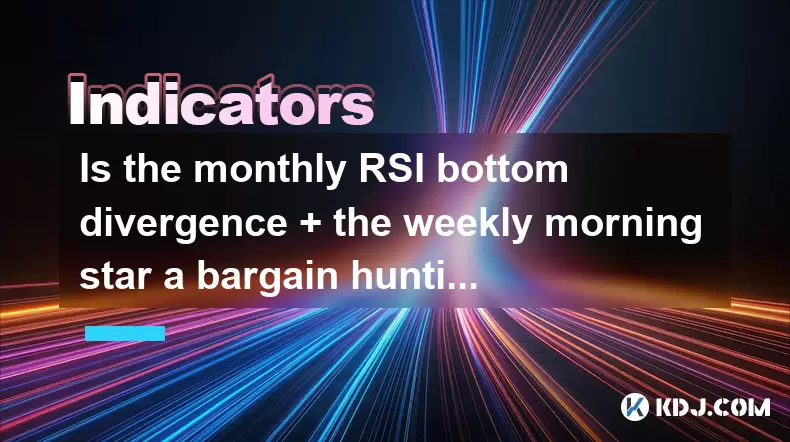
Is the monthly RSI bottom divergence + the weekly morning star a bargain hunting opportunity?
Jun 30,2025 at 09:57pm
Understanding RSI Bottom Divergence in Monthly TimeframesThe Relative Strength Index (RSI) is a momentum oscillator commonly used to identify overbought or oversold conditions in the market. When traders refer to a monthly RSI bottom divergence, they're observing a situation where the price makes a lower low, but the RSI makes a higher low on the monthl...
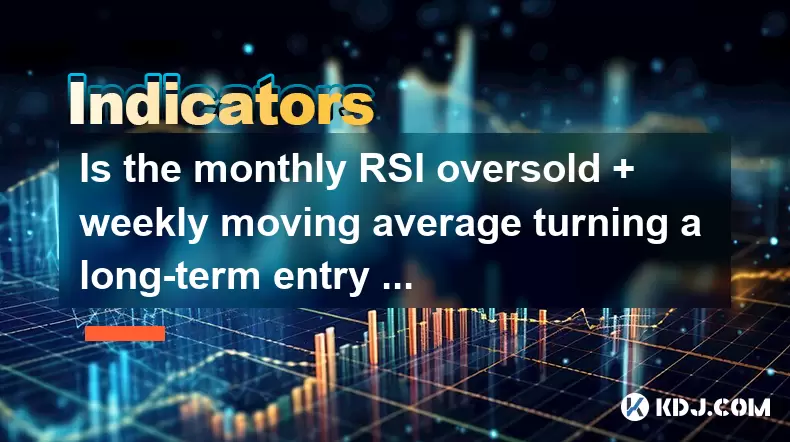
Is the monthly RSI oversold + weekly moving average turning a long-term entry signal?
Jun 30,2025 at 11:42pm
Understanding RSI and Its Role in Cryptocurrency TradingThe Relative Strength Index (RSI) is a momentum oscillator commonly used by traders to identify overbought or oversold conditions in the market. In the context of cryptocurrency, where volatility reigns supreme, understanding how RSI behaves on different timeframes becomes crucial. When the monthly...
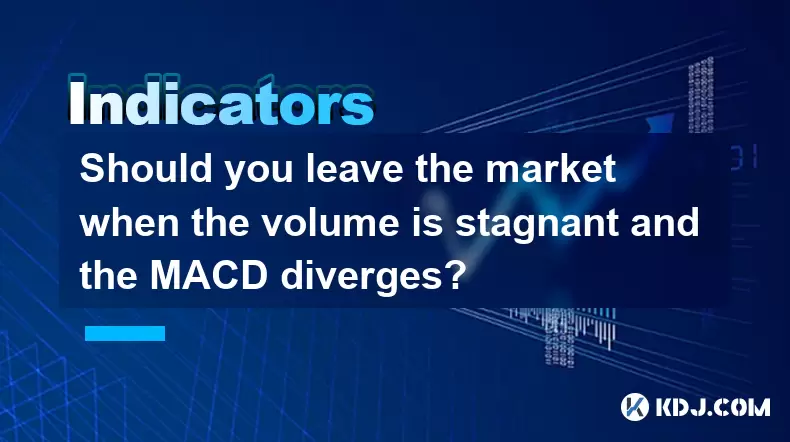
Should you leave the market when the volume is stagnant and the MACD diverges?
Jun 30,2025 at 09:36pm
Understanding Volume Stagnation in Cryptocurrency TradingIn the realm of cryptocurrency trading, volume plays a crucial role in determining the strength of price movements. When volume remains stagnant over an extended period, it suggests that neither buyers nor sellers are showing strong conviction. This often leads to sideways movement or consolidatio...
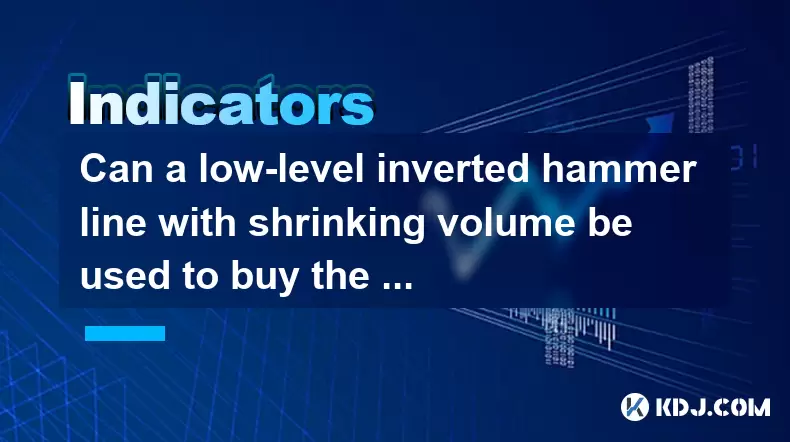
Can a low-level inverted hammer line with shrinking volume be used to buy the bottom?
Jul 01,2025 at 12:08am
Understanding the Low-Level Inverted Hammer LineA low-level inverted hammer line is a candlestick pattern that typically appears at the bottom of a downtrend. It consists of a small real body near the top of the trading range with a long upper shadow and little or no lower shadow. This formation suggests that buyers attempted to push prices higher but w...

Can I add positions if the daily line breaks through the descending channel + the 30-minute moving average is in a bullish arrangement?
Jun 30,2025 at 11:00pm
Understanding the Descending Channel BreakoutWhen a daily line breaks through a descending channel, it indicates a potential shift in market sentiment from bearish to bullish. A descending channel is formed by drawing two parallel trendlines, where the upper trendline connects the lower highs and the lower trendline connects the lower lows. A breakout o...

Should we guard against trend reversal when the monthly RSI is overbought + the weekly line has a long upper shadow?
Jun 30,2025 at 11:35pm
Understanding RSI Overbought Conditions in CryptocurrencyThe Relative Strength Index (RSI) is a momentum oscillator commonly used in technical analysis to identify overbought or oversold conditions in an asset. When the monthly RSI of a cryptocurrency reaches above 70, it is generally considered overbought, suggesting that the asset may be due for a pul...

Is the monthly RSI bottom divergence + the weekly morning star a bargain hunting opportunity?
Jun 30,2025 at 09:57pm
Understanding RSI Bottom Divergence in Monthly TimeframesThe Relative Strength Index (RSI) is a momentum oscillator commonly used to identify overbought or oversold conditions in the market. When traders refer to a monthly RSI bottom divergence, they're observing a situation where the price makes a lower low, but the RSI makes a higher low on the monthl...

Is the monthly RSI oversold + weekly moving average turning a long-term entry signal?
Jun 30,2025 at 11:42pm
Understanding RSI and Its Role in Cryptocurrency TradingThe Relative Strength Index (RSI) is a momentum oscillator commonly used by traders to identify overbought or oversold conditions in the market. In the context of cryptocurrency, where volatility reigns supreme, understanding how RSI behaves on different timeframes becomes crucial. When the monthly...

Should you leave the market when the volume is stagnant and the MACD diverges?
Jun 30,2025 at 09:36pm
Understanding Volume Stagnation in Cryptocurrency TradingIn the realm of cryptocurrency trading, volume plays a crucial role in determining the strength of price movements. When volume remains stagnant over an extended period, it suggests that neither buyers nor sellers are showing strong conviction. This often leads to sideways movement or consolidatio...

Can a low-level inverted hammer line with shrinking volume be used to buy the bottom?
Jul 01,2025 at 12:08am
Understanding the Low-Level Inverted Hammer LineA low-level inverted hammer line is a candlestick pattern that typically appears at the bottom of a downtrend. It consists of a small real body near the top of the trading range with a long upper shadow and little or no lower shadow. This formation suggests that buyers attempted to push prices higher but w...
See all articles

























































































